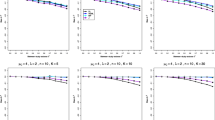Abstract
This paper proposes the use of signal-to-noise ratio (SNR) as another index of a measurement’s reproducibility. We derive its maximum likelihood estimation and discuss confidence interval construction within the framework of the one-way random effect model. We investigate the validity of the approximate normal confidence interval by Monte-Carlo simulations. The paper also derives the optimal allocation for the number of subject and the number of repeated measurements needed to minimize the variance of the maximum likelihood estimator of the SNR. We discuss efficiency in estimation and cost considerations for the optimal allocation of the sample resources. The approach is illustrated on two examples: one from MRI data and the other on the WHO immunization coverage data.

Similar content being viewed by others
References
Ashton, E.A., Takahashi, C., Berg, M.J., Goodman, A., Totterman, S., Ekholm S.: Accuracy and reproducibility of manual and semi automated quantification of MS lesions by MRI. J. Magn. Reson. Imaging 17, 300–308 (2003)
Berube, Wu: Signal-to-noise ratio and related measures in parameter design optimization: an overview. Sankhya 62, 417–432 (2000)
Box, G.: Signal-to-noise ratios, performance criteria, and transformations (with discussion). Technometrics 30, 1–40 (1988)
Box, G., Bisgaard, S.: The scientific context of quality improvement. Qual. Prog. 6, 54–61 (1987)
Cunningham, I., Shaw, R.: Signal-to-noise optimization of medical imaging system. J. Opt. Soc. Am. A 16, 621–632 (1999)
Dunn, G.: Design and analysis of reliability studies. Stat. Methods Med. Res. 1, 123–157 (1992)
Fleiss, J.: Design and Analysis of Clinical Experiments. Wiley, New York (1986)
Jung, J.A., Coakley, F.V., Vigneron, D.B., Swanson, M.G., Qayyum, A., Weinberg, V., Jones K.D., Carroll, P.R., Kurhanewicz, J.: Prostate depiction at endorectal MR spectroscopic imaging: investigation of a standardized evaluation system. Radiology 233, 701–708 (2004)
Kendall, M., Stuart, A.: The Advanced Theory of Statistics. Griffin, London (1986)
Mian, I., Shoukri, M., Tracy, D.: Maximum likelihood estimation of sibling correlations in the analysis of family data. J. Stat. Plan. Inference 27, 125–141 (1991)
Nair, V.: Taguchi’s parameter design: a panel discussion. Technometrics 34, 127–160 (1992)
Nair, V., Pregibon, D.: A data analysis strategy for quality engineering experiments. AT&T Tech. J. 65, 73–84 (1986)
Rao, S.: Optimization: Theory and Applications. Wiley Eastern Limited, New Delhi (1994)
Scheffe, H.: The Analysis of Variance. Wiley, New York (1959)
Shoukri, M.M.: Measures of Inter-observer Agreement. Chapman & Hall/CRC Press, Boca Raton, FL (2004)
Sim, K.S., Kamel, N.S.: Image signal-to-noise ratio estimation using the autoregressive model. Scanning 26, 135–139 (2004)
Srinivasan, S., Ophir, J., Alam, S.K.: Theoretical derivation of SNR, CNR and spatial resolution for a local adaptive strain estimator for elastography. Ultrasound Med. Biol. 30, 1185–1197 (2004)
Sukhatme, P., Sukhatme, B., Sukhatme, S., Asok, C.: Sampling Theory of Surveys with Applications. Iowa State University Press, Ames, IA (1984)
Taguchi, G.: Introduction to Quality Engineering: Designing Quality into Products and Processes. Kraus International Publications, White Plains, NY (1986)
Taguchi, G., Wu, Y.: Introduction to Off-line Quality Control. Central Japan Quality Control Association, Nagaya, Japan (1985)
Tukey, J.: Variance of variance components: I. Balanced design. Ann. Math. Stat. 27, 722–736 (1956)
World Health Organization, Department of Immunization Vaccines and Biologicals, Vaccine Assessment and Monitoring Team.http://www.who.int/vaccines-surveillance. Accessed 16 Apr 2005
Author information
Authors and Affiliations
Corresponding author
Rights and permissions
About this article
Cite this article
Elkum, N., Shoukri, M.M. Signal-to-noise ratio (SNR) as a measure of reproducibility: design, estimation, and application. Health Serv Outcomes Res Method 8, 119–133 (2008). https://doi.org/10.1007/s10742-008-0030-2
Received:
Revised:
Accepted:
Published:
Issue Date:
DOI: https://doi.org/10.1007/s10742-008-0030-2




